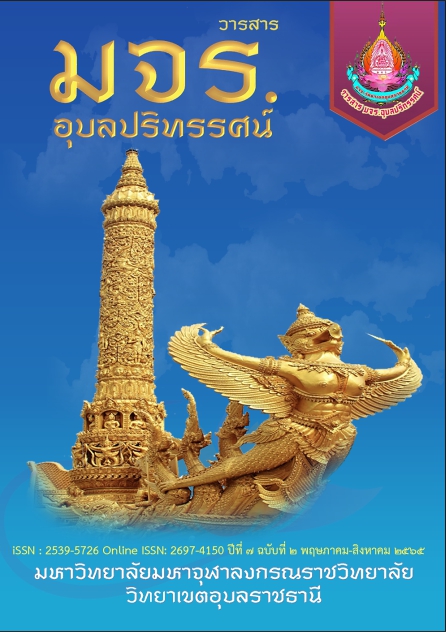BURNOUT LEVEL OF NO-RANK TEACHER UNDER THE BANGKOK SECONDARY EDUCATION SERVICE AREA OFFICE SECTION 2, RATCHAYOTHIN UNITED CAMPUS
Main Article Content
Abstract
This research article aims to 1) study levels of burnt-out conditions in No-rank teachers under the Bangkok secondary education Service Area Office Section 2, RATCHAYOTHIN United campus. 2) compare levels of burnt-out in No-rank Teachers separated by individual factors and workload factors. The tools used in this research were a 7-level estimate scale questionnaire by collecting data from a sample of No-Rank Teachers under the Bangkok secondary education Service Area Office Section 2, RATCHAYOTHIN United campus, a total of 160 people. The statistics used for data analysis were frequency distribution, percentage, mean, standard deviation, t-test, ANOVA, and Least Significant Difference. The result of the research indicated that 1) the level of burnt-out in No-Rank Teachers under the Bangkok secondary education Service Area Office Section 2, RATCHAYOTHIN United campus, Emotional Exhaustion factor at low level 61 people (38.1%), intermediate level 37 people (23.1%), high level 62 people (38.8%). Depersonalization factor at low level 108 people (67.5%), intermediate level 32 people (20%), high level 20 people (12.5%). Decreased Occupational Accomplished factor at low level 42 people (26.3%), intermediate level 38 people (23.8%), and high level 80 people (50%). 2) comparison of the burnt-out condition of individual factors divided by gender, age, marriage status, service period, salary, and family obligation. And workload factor divided by teaching hours and other things apart from teaching found that gender, age, salary, family obligation, and teaching hours of No-rank teachers under the Bangkok secondary education Service Area Office Section 2, RATCHAYOTHIN United campus were not different. For the individual factor, marriage status and service period have statistically significant at 0.05. For the Emotional exhaustion factor and the Depersonalization factor in part of other things apart from teaching have, the level of burnt-out condition statistically significant at 0.05.
Article Details
References
กรมสุขภาพจิต กระทรวงสาธารณสุข. (2560). แบบสอบถามภาวะหมดไฟในการทำงาน.
สืบค้นเมื่อวันที่ 20 มีนาคมคม, 2564, จาก https://mhc7.go.th/wp-content/uploads/2017/09/แบบประเมินภาวะหมดไฟ-ฉบับเผยแพร่.pdf
ฉัตรชกรณ์ ระบิล. (2564). ภาวะหมดไฟในการทำงานของบุคลากรในสำนักงานคณะกรรมการการศึกษาขั้นพื้นฐาน. วารสารสวนสุนันทาวิชาการและวิจัย, ปีที่ 15 ฉบับที่ 2 (กรกฎาคม-ธันวาคม), กรุงเทพมหานคร.
ชัยยุทธ กลีบบัว และพรรณรพี สุทธิวรรณ. (2552). การพัฒนาโมเดลเชิงสาเหตุของความเหนื่อยล้าในการทำงาน. วารสารวิธีวิทยาการวิจัย, ปีที่ 12 ฉบับที่ 3 (กันยายน-ธันวาคม), กรุงเทพมหานคร.
จิรัชญา ชัยชุมขุน. (2564). ภาระงานล้น แต่เงินน้อย สรุปปัญหา #ทำไมครูไทยอยากลาออก เมื่อครูถูกผลักให้เป็นผู้เสียสละ. สืบค้นเมื่อวันที่ 1 ธันวาคม 2564, จาก https://thematter.co/social/education/why-thai-teachers-wanna- quit/160415#:~:text=
ปทุมรัตน์ สกลพิมลรัตน์. (2556). ภาวะหมดไฟในการทำงานของพนักงานระดับปฏิบัติการ บริษัท วีรับเบอร์ คอร์ปอเรชั่น จำกัด. บัณฑิตวิทยาลัย : มหาวิทยาลัยศิลปากร.
เพ็ญพิชชา เกตุชัยโกศล. (2564). ภาวะหมดไฟในการทำงาน (Burnout) ของพนักงาน บริษัทเอกชน ในกลุ่ม Generation Y. บัณฑิตวิทยาลัย : มหาวิทยาลัยมหิดล.
ละม้าย เกิดโภคทรัพย์. (2548). การรับรู้ความสามารถของตนเองกับความเหนื่อยหน่ายใน งานของบุคลากรทางการพยาบาล : กรณีศึกษาโรงพยาบาลแห่งหนึ่ง. บัณฑิต วิทยาลัย : มหาวิทยาลัยธรรมศาสตร์.
วรรณพร พรายสวาท. (2552). ความสัมพันธ์ระหว่างการฟังเพลงในขณะทำงานกับความสุข ในการทำงาน : ศึกษา เฉพาะกรณี พนักงานขายของบริษัท อิริคสัน (ประเทศไทย) จำกัด. บัณฑิตวิทยาลัย : มหาวิทยาลัยเทคโนโลยีพระจอมเกล้าพระนคร.
เหมือนขวัญ จรงค์หนู. (2562). ความสัมพันธ์ระหว่างภาวะหมดไฟและประสิทธิภาพในการ ปฏิบัติงานของบุคลากรในสายสนับสนุนวิชาการในมหาวิทยาลัย. บัณฑิตวิทยาลัย : มหาวิทยาลัยเทคโนโลยีพระจอมเกล้าพระนคร.
Maslach, C., Schaufeli, W. B., & Leiter and. M. P. (2001). Job burnout. Annual Review of Psychology, 52: 397-422.

